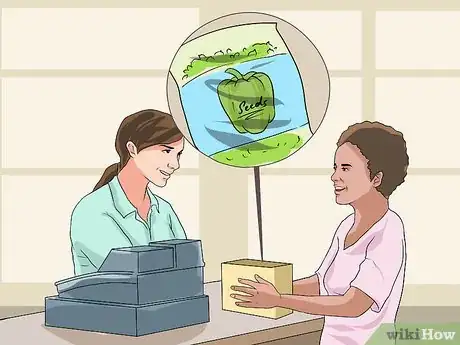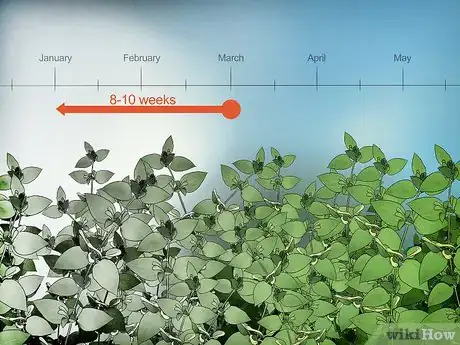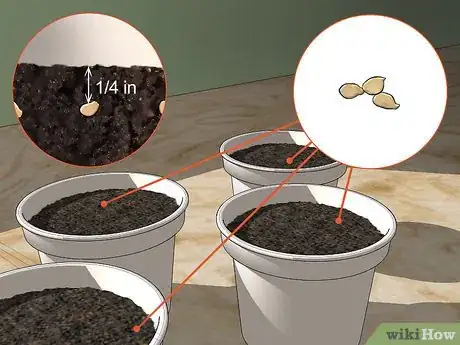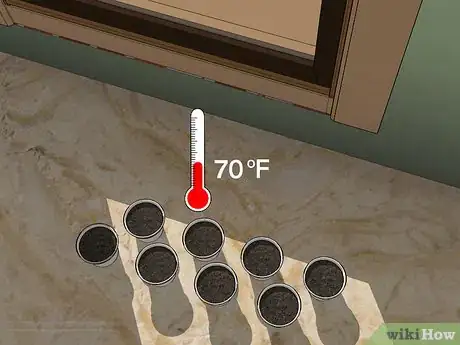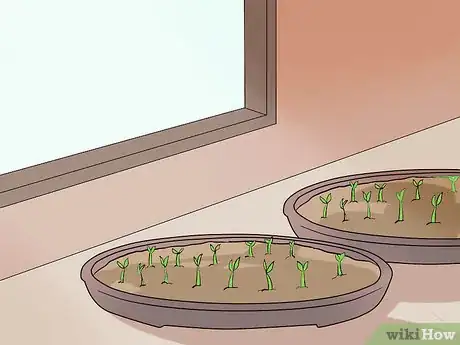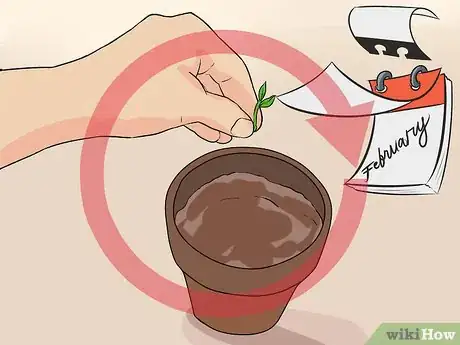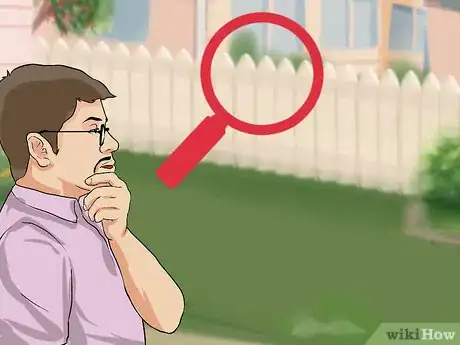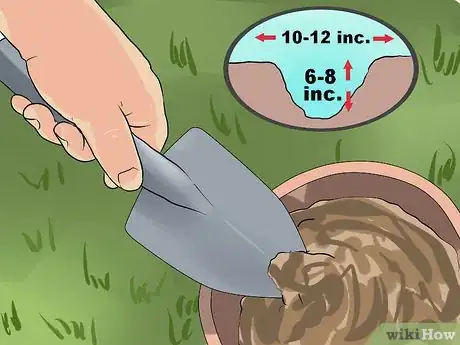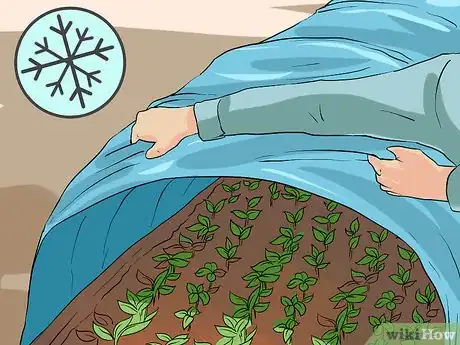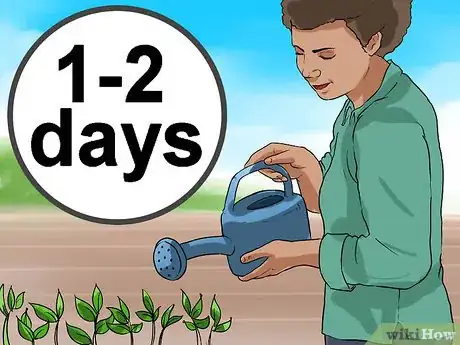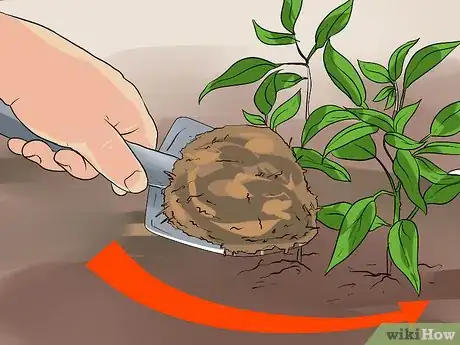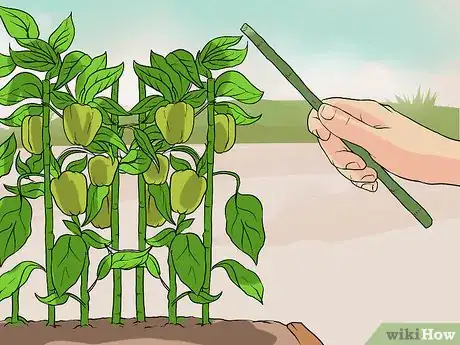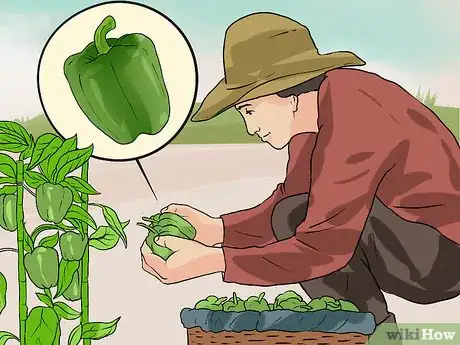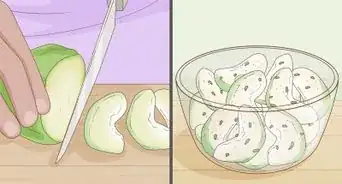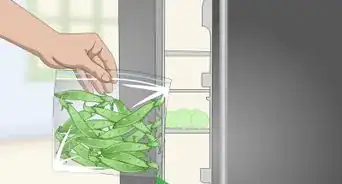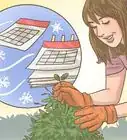This article was co-authored by Andrew Carberry, MPH. Andrew Carberry is a Food Systems Expert and the Senior Program Associate at the Wallace Centere at Winrock International in Little Rock, Arkansas. He has worked in food systems since 2008 and has experience working on farm-to-school projects, food safety programs, and working with local and state coalitions in Arkansas. He is a graduate of the College of William and Mary and holds a Masters degree in public health and nutrition from the University of Tennessee.
There are 10 references cited in this article, which can be found at the bottom of the page.
wikiHow marks an article as reader-approved once it receives enough positive feedback. This article received 23 testimonials and 99% of readers who voted found it helpful, earning it our reader-approved status.
This article has been viewed 548,584 times.
You don’t have to be an experienced gardener to grow luscious, vibrant green bell peppers. All it takes is patience, attention and a little knowledge of the right growing conditions. Green peppers, like most other varieties, thrive in the heat, which is why they have such a celebrated history in countries with arid climates. With this in mind, it’s important to know where to begin cultivating green pepper seedlings, how frequently to water them and when the best time is to transplant them outside to grow on their own.
Steps
Cultivating Green Pepper Seeds
-
1Purchase green pepper seeds from the grocery store or farmer’s market. Visit your local grocery, farmer’s market or plant nursery and buy a package of green bell pepper seeds. Peppers come in many different varieties, and some options might not be available at all times of the year. Shop around until you find a place that sells healthy, organic green bell pepper seeds.[1]
- If you have a large garden, make the most of your planting space and look into other types of peppers that can be grown alongside green peppers.
- You can also save and reuse seeds from the previous year's harvest if you've grown green peppers in the past.
-
2Calculate the last frost date for your area. The Old Farmer’s Almanac can help you calculate the last frost date for where you live to determine what week you should plant your seeds. Pepper seeds should be planted 8-10 weeks before the last frost date. You will transfer your seeds outside just after the last frost date.[2]Advertisement
-
3Plant three seeds per container ¼ in (1/2 cm) deep. Use any pot or vessel the size of a yogurt cup or larger with a hole in the bottom to plant your seeds.[3] Use a fine-textured seed-starting mix that allows a lot of drainage.[4] Water your seeds to the point of dampness but not saturation.
- Never allow your seeds’ soil to dry out completely.[5]
- Young plants that grow slowly and produce droopy, shriveled fruit or foliage may be receiving too much or too little water.
-
4Keep your seeds in a room at least 70 degrees F (21 degrees C). Pepper seeds require warmth to germinate. Find a room in your house that gets good sun and maintains a temperature of at least 70 degrees F (21 degrees C).[6] You can use a wall thermometer to determine the temperature if your thermostat is unreliable.
-
5Remove the weakest seedling. Pepper plants thrive best in pairs, as the two plants can shade each other from excess sun. A few weeks into the seedlings growth, remove the one that is thriving least so the other two can flourish.[7]
-
6Keep growing plants exposed to sunlight. Take the seedlings you planted in shallow planters and set them on a south-facing windowsill to soak up light and warmth during the day. It’s important for green peppers to have ample light in order to grow.[8]
- After seeding them inside, you should gradually begin to expose your green pepper plants to outdoor conditions. Leaving the window open to allow direct sunlight and air flow is a good way to start.[9]
- Green peppers should get at least 5-6 hours of sunlight per day. If you don’t have a window with lots of light, consider an artificial grow light.
Transplanting Green Peppers to the Garden
-
1Wait until the right time in the season. Transplanting should be done immediately following the last frost date when the weather begins to warm. In hotter climates, this will usually be around March or April. If you live in a location that experiences lasting winter temperatures, you might have to wait until closer to summer to plant viable young peppers. Green peppers can be grown basically year-round in arid regions where the environment is hot and temperate. Just make sure your plants get enough water if you're growing them in a place that's hot with dry conditions.[10]
- Most people should plan on starting their seedlings indoors around late January or early February and transplanting them after around 10 weeks.[11]
- Keep row covers on your green pepper plants at night after they’ve been transplanted outside to help them retain heat.
-
2Find an open, sunny space in your garden. Set aside a corner of your garden with plenty of room to continue growing the green peppers. The site you choose should have soil that is well-drained, rich and dark. Try to choose a location that receives direct sunlight, and make sure you plant the peppers far enough away from other hearty fruits and vegetables to avoid competition for nutrients.[12]
- Green peppers do best if they’re grown in places with temperatures around 70 degrees or hotter.[13]
- Don’t plant harvesting vegetables like green peppers near leafy plants that may be eaten by rabbits and other foraging animals.
-
3Dig holes large enough to accommodate growing pepper plants. Use a shovel or hand trowel to dig holes roughly 6-8 inches deep and 10-12 inches wide. Aerate the soil around the holes thoroughly. Plant the green pepper seedlings in the holes and refill them loosely.[14]
- Green peppers should be planted approximately 18-24 in (46-60 cm) apart to have room to grow without overtaking one another.
-
4Add a little fertilizer to the soil. Work a little organic fertilizer, such as blood meal or organic compost, into the soil to keep the pepper plants fed. Don’t use too much: about a teaspoon worth will do the trick. Green peppers take most of their sustenance from the soil they grow in, so overfertilizing can actually leach nutrients from the plants and in severe cases may even kill them.[15]
- Some gardeners recommend placing a few matchsticks heads-down in the soil around a pepper plant to give them the little bit of sulfur they require.[16]
-
5Cover the plants with row covers when it’s cold. In order to keep your green peppers growing healthy and robust, you need to keep them warm. Shield the plants with insulated row covers on particularly cold nights or whenever a frost is expected. The row covers trap the heat that the peppers need while also providing a barrier from precipitation, runoff and grazing scavengers.[17]
- It’s okay to leave row covers on heat-loving plants like green peppers in milder climates.
- Always wait until early spring to plant peppers. Chill weather can kill them or severely hinder their growth.
Growing Healthy Green Peppers
-
1Water green pepper plants regularly. Give your green pepper plants a healthy drink every 1-2 days, depending on what the weather is like. You can water less frequently as your plants mature and develop stronger roots. Peppers grown in hotter climates will likely need more water. An inch or two of water per week is best for most green pepper plants of average size in moderate growing conditions. Avoid overwatering, as this can kill the plant or make it susceptible to disease.[18]
- Make sure plot you pick out is well-drained so that water doesn’t pool around the plants and turn the soil soggy.
-
2Mix organic matter into the soil around the plants. Break up the soil around the plants every few weeks and add a shovelful of mulch or compost. Your green peppers will grow more efficiently if they can feed off the organic matter. Some pepper plants don’t even need a separate fertilizer if a little compost is added to the soil at intervals.
- Organic materials like mulch also help the soil retain moisture, which is useful for making sure green pepper plants get enough water in hot weather.
- Since calcium deficiency can cause the bottom end to rot on peppers, you can increase the amount of calcium in your soil by grinding eggshells and mixing it in with your soil (alternatively, use lime). If you use a fertilizer, make sure it has lower nitrogen content and it is not ammonia-based. Excess nitrogen and ammonium can be a cause of calcium deficiency.
-
3Support the plants with garden stakes once they’re large enough. As your peppers grow, the fruit can become heavy, putting strain on the stalk. Correct this by tying the pepper stalks to wooden garden stakes, which will help the plant support its own weight. Stakes can be bought cheap at most gardening centers.[19]
- Secure the plant’s stalks to the stakes using pantyhose or rubber bands rather than ordinary plastic ties. The added flexibility will ensure that the tie doesn’t constrict the plant’s growth or cause stress or breakage to the stalk.[20]
-
4Harvest green peppers when they’re fully grown. Green peppers are ready to be harvested by the time they’ve reached the desired size, typically 3-4 inches in length. Most of the time, however, knowing whether a pepper is ripe is determined by its color. Mature peppers will exhibit a deep green hue that is darker than the stalk and stem of the plant. Remove ripe peppers from their stems using a sharp knife or gardening shears. Rinse and dry peppers before cooking with them, or store them in the refrigerator until they’re ready to be used.
- Most varieties of green bell peppers will be ready to harvest between 60-90 days after they're transplanted outdoors.[21]
- Green peppers will stay fresh in the refrigerator for up to two weeks.
Expert Q&A
Did you know you can get expert answers for this article?
Unlock expert answers by supporting wikiHow
-
QuestionHow can I store green peppers for longer periods of time?
 Andrew Carberry, MPHAndrew Carberry is a Food Systems Expert and the Senior Program Associate at the Wallace Centere at Winrock International in Little Rock, Arkansas. He has worked in food systems since 2008 and has experience working on farm-to-school projects, food safety programs, and working with local and state coalitions in Arkansas. He is a graduate of the College of William and Mary and holds a Masters degree in public health and nutrition from the University of Tennessee.
Andrew Carberry, MPHAndrew Carberry is a Food Systems Expert and the Senior Program Associate at the Wallace Centere at Winrock International in Little Rock, Arkansas. He has worked in food systems since 2008 and has experience working on farm-to-school projects, food safety programs, and working with local and state coalitions in Arkansas. He is a graduate of the College of William and Mary and holds a Masters degree in public health and nutrition from the University of Tennessee.
Food Systems Expert
-
QuestionOur peppers don't seem to be growing past 1.5 inches long. Is there such a thing as miniature green bell peppers? We are growing them in a Topsy Turvy planter. Is that okay?
 Andrew Carberry, MPHAndrew Carberry is a Food Systems Expert and the Senior Program Associate at the Wallace Centere at Winrock International in Little Rock, Arkansas. He has worked in food systems since 2008 and has experience working on farm-to-school projects, food safety programs, and working with local and state coalitions in Arkansas. He is a graduate of the College of William and Mary and holds a Masters degree in public health and nutrition from the University of Tennessee.
Andrew Carberry, MPHAndrew Carberry is a Food Systems Expert and the Senior Program Associate at the Wallace Centere at Winrock International in Little Rock, Arkansas. He has worked in food systems since 2008 and has experience working on farm-to-school projects, food safety programs, and working with local and state coalitions in Arkansas. He is a graduate of the College of William and Mary and holds a Masters degree in public health and nutrition from the University of Tennessee.
Food Systems Expert
-
QuestionCan I grow peppers or any other vegetables on a balcony?
 Community AnswerI don't see why not! As long as the peppers have healthy soil, water, sunlight and a big enough planter, you can grow them just about anywhere.
Community AnswerI don't see why not! As long as the peppers have healthy soil, water, sunlight and a big enough planter, you can grow them just about anywhere.
Warnings
- Wait to plant your green peppers until outdoor nighttime temperatures are around 50 degrees Fahrenheit or higher. Otherwise, the chill may cause the plants to die.⧼thumbs_response⧽
- Avoid planting green pepper plants near vegetables like fennel and kohlrabi, as these can be detrimental to the growth of other vegetables.⧼thumbs_response⧽
Things You'll Need
- Green pepper seeds or young plants
- Growing container
- Germination mat (optional)
- Organic fertilizer
- Compost or mulch
- Row covers
- Water
References
- ↑ http://www.gardenersnet.com/vegetable/pepper.htm
- ↑ http://www.almanac.com/gardening/frostdates/IL/Chicago
- ↑ http://www.johnnyseeds.com/growers-library/vegetables/growing-tips-successful-pepper-transplants.html
- ↑ http://www.johnnyseeds.com/growers-library/vegetables/growing-tips-successful-pepper-transplants.html
- ↑ https://www.growveg.com/guides/how-to-grow-peppers-in-containers/
- ↑ http://www.almanac.com/plant/bell-peppers
- ↑ http://www.almanac.com/plant/bell-peppers
- ↑ http://www.burpee.com/gardenadvicecenter/areas-of-interest/seed-starting/growing-peppers/article10252.html
- ↑ https://www.goodhousekeeping.com/home/gardening/a20705612/growing-peppers/
- ↑ http://www.almanac.com/content/frost-chart-united-states
- ↑ http://www.burpee.com/gardenadvicecenter/areas-of-interest/seed-starting/growing-peppers/article10252.html
- ↑ https://www.goodhousekeeping.com/home/gardening/a20705612/growing-peppers/
- ↑ http://www.gardenersnet.com/vegetable/pepper.htm
- ↑ http://www.burpee.com/gardenadvicecenter/areas-of-interest/seed-starting/growing-peppers/article10252.html
- ↑ http://www.burpee.com/gardenadvicecenter/areas-of-interest/seed-starting/growing-peppers/article10252.html
- ↑ http://www.almanac.com/plant/bell-peppers
- ↑ http://www.gardeners.com/how-to/row-covers/5111.html
- ↑ https://www.goodhousekeeping.com/home/gardening/a20705612/growing-peppers/
- ↑ http://www.burpee.com/gardenadvicecenter/areas-of-interest/seed-starting/growing-peppers/article10252.html
- ↑ https://bonnieplants.com/library/how-to-support-tomatoes/
- ↑ http://www.burpee.com/gardenadvicecenter/areas-of-interest/seed-starting/growing-peppers/article10252.html
About This Article
To grow green bell peppers from seed, plan to start the seeds indoors 8-10 weeks before the last frost in your area. Start the seeds in small pots about the size of a yogurt cup and put 3 seeds in each pot. Plant them about ¼ inch (0.6 cm) deep in well-drained seed-starting soil. Keep the soil damp but not sopping wet, and water the seeds any time the soil starts to dry out. Store the seed containers in a room where the temperature stays around 70 °F (21 °C). If possible, place them in a south-facing window so they get plenty of sun during the day. Once the seedlings have been growing for a few weeks, remove the smallest one from each pot. After the last frost date in spring, begin hardening the seedlings off by exposing them to outdoor conditions for a few hours a day. Find a sunny spot with rich, well-drained soil to plant them outside. Dig holes that are about 6-8 inches (15-20 cm) deep and 10-12 inches (25-30 cm) across and place the pepper plants in them, then fill the holes loosely with soil. Space your plants about 18-24 inches (46-60 cm) apart. Add a pinch of organic fertilizer to the soil around each plant. Water your plants every 1-2 days and cover them when it gets cold out. Once they get tall enough to start growing peppers, support the plants by gently tying them to stakes. Harvest peppers from the plants when the peppers are dark green and 3-4 inches (8-10 cm) long. For more advice from our Gardening reviewer, including how to protect your pepper plants when the weather turns cold, keep reading.
